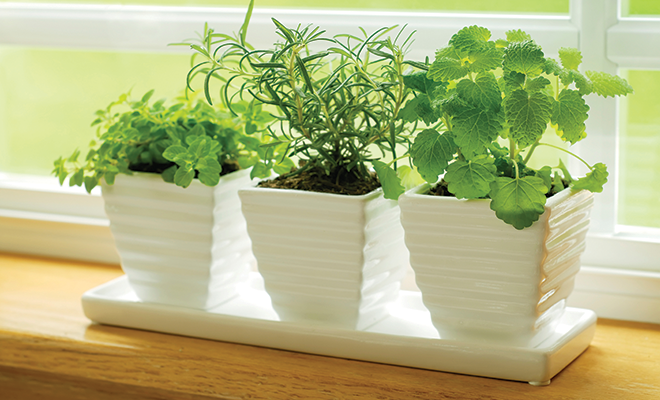
Add a Few Sprigs of Home-Grown Cilantro!
A sprinkle of parsley, a bundle of rosemary–fresh herbs offer a variety of benefits for a meal, adding depth of flavor and boosting the look of any dish you serve at home.
We typically see fresh herbs used in dishes when we’re dining out; we’re often impressed by how much a simple sprig of parsley or lemongrass enhances a meal or how much flavor a sprinkling of chive adds to an otherwise average ingredient. But did you know it’s fairly easy to cultivate your own herb garden for home cooking?
Why don’t more home chefs have their own selection of fresh herbs on hand? Some of the most common obstacles to creating home herb gardens are a lack of sunlight, space or even a stubborn and unpredictable climate. However, even these challenges can be overcome with a few strategic tips and a little planning. Once you have the logistics down for your indoor or outdoor herb garden, you can begin growing your own selection of delicious, fragrant herbs.
Kitchen herb gardens can be grown in a variety of settings – you just need to make a few small alterations to the space in order to create a thriving environment for your herbs.
Outdoor patio
Whether you have lots of outdoor space or not, maximize your growing potential by creating a vertical garden composed of hanging baskets and multi-level stands. Since plant containers are generally on the smaller size, you can easily grow a multitude of herbs on a single stand or pallet.
Garden area
If you have the garden space available, incorporate an area of the landscape for kitchen herbs! Keep them easy to reach and convenient by placing them on the outside of the garden, close to the kitchen door, so you can quickly pluck what you need for any meal. Landscape experts also suggest keeping kitchen herbs in containers so they are easy to move during cooler weather; that way you have access to fresh herbs all year long.
Indoor garden
Growing herbs indoors is easier than it sounds; you just need to have light! There are a few ways to get around this, either by placing herb containers on a windowsill with full eastern or southern sun, or placing potted herbs under a light in the kitchen itself, perhaps with under-cabinet lighting or an herb garden growing system, which may be purchased online or in retail stores.
Once you have the ideal space in mind, the next step is to decide what herbs to incorporate into the indoor or outdoor garden. Here are a few tips to consider when planning the herbs you’ll want to use in your dishes.
Choose your favorites
Select herbs that you’ll use frequently and that you like! For example, if you make a variety of ethnic dishes or love to use something specific often, then those herbs are the best option. The most commonly used fresh herbs include rosemary, basil, parsley and cilantro.
Provide access to light
Whether you plant indoors or outdoors, your herbs need plenty of light. Move the containers around as needed to provide consistent lighting to all of the plants, which will help promote even growth. Depending on the type of herb you grow, light needs may vary; a good rule of thumb is to provide herbs with at least five hours of full light.
Ideal growing conditions
Choose a place that has good air flow throughout and maintains an average temperature of 55 to 75 degrees. During colder months, the spot on the windowsill might be too cold for herbs to thrive, so be sure to move them to warmer locations in the house or on the patio.
Proper watering needs
Changes in temperature and light during the year cause plants to require varying amounts of water. For example, herbs grow slower in winter and do not need as much water as they will in spring and summer. Also, allow the soil to properly drain between watering. Certain herbs require a drier soil to thrive, while other varieties, such as mint or basil, do better in moist soil. One easy way to test soil conditions is to press your finger into the soil about an inch deep; if the soil is dry below the surface, it’s time to water.
After you have your kitchen herb garden in place, simply maintain a proper water and light schedule and watch them grow! Pruning and trimming are necessary to encourage new growth as you begin to use the fresh herbs for cooking. Always refer to the garden guide provided with the plants to ensure you use the proper techniques.
Planting an herb garden is easy and ensures you have the best ingredients to boost any favorite meal at home! ■
Sources: cookinglight.com, rodalesorganiclife.com and thekitchn.com.







